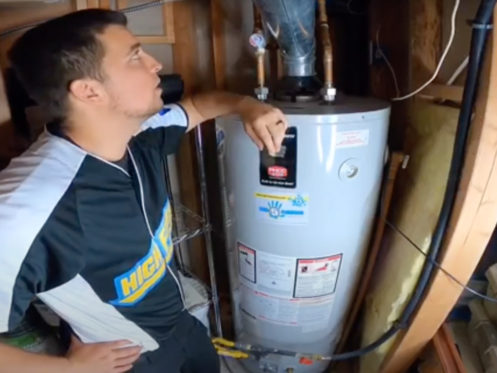Listed here on the next paragraphs yow will discover a lot of superb guidance on the subject of What Kind of Maintenance Do Water Heaters Need?.

Hot water is necessary for daily convenience, whether it's for a refreshing shower or washing recipes. To guarantee your hot water system runs successfully and lasts longer, routine maintenance is crucial. This article offers functional tips and understandings on how to preserve your home's warm water system to avoid interruptions and pricey repair work.
Intro
Maintaining your home's hot water system could seem complicated, yet with a few simple actions, you can guarantee it runs smoothly for years ahead. This guide covers everything from understanding your hot water system to DIY upkeep tips and recognizing when to call specialist aid.
Significance of Maintaining Your Hot Water System
Routine upkeep not just expands the lifespan of your hot water system however additionally ensures it operates efficiently. Ignoring upkeep can bring about lowered performance, greater energy bills, and even premature failure of the system.
Indications Your Warm Water System Requirements Maintenance
Understanding when your warm water system requires focus can protect against significant issues. Look out for indicators such as irregular water temperature level, strange noises from the heater, or rusty water.
Flushing the Hot Water Heater
Purging your hot water heater gets rid of debris accumulation, enhancing effectiveness and extending its life.
Checking and Replacing Anode Rods
Anode poles protect against deterioration inside the container. Evaluating and changing them when broken is important.
Complicated Problems Requiring Professional Help
Instances consist of significant leakages, electric issues, or if your water heater is regularly underperforming.
Routine Professional Upkeep Conveniences
Expert upkeep can include comprehensive inspections, tune-ups, and ensuring conformity with security standards.
Evaluating and Readjusting Temperature Settings
Readjusting the temperature level settings ensures optimum performance and safety.
Do It Yourself Tips for Maintenance
You can perform numerous maintenance jobs on your own to keep your hot water system in top condition.
Checking for Leakages
Routinely check pipes and connections for leakages, as these can result in water damages and higher bills.
Recognizing Your Hot Water System
Prior to diving into upkeep tasks, it's helpful to recognize the fundamental parts of your hot water system. Commonly, this consists of the water heater itself, pipelines, anode rods, and temperature level controls.
Monthly Upkeep Tasks
Regular regular monthly checks can help catch small problems prior to they escalate.
Examining Pressure Relief Valves
Examining the pressure safety valve ensures it works correctly and stops excessive pressure accumulation.
Insulating Pipes
Shielding hot water pipes lowers heat loss and can save power.
When to Call a Professional
While DIY upkeep is advantageous, some problems call for professional competence.
Verdict
Regular upkeep of your home's warm water system is important for effectiveness, long life, and cost savings. By complying with these ideas and knowing when to seek expert aid, you can ensure a reputable supply of hot water without unforeseen disturbances.
Water Heater Maintenance Tips
Test the TPR Valve
Shut off the power and the cold-water supply valve. Place a bucket under the pipe connected to the temperature-pressure-release (TPR) valve on the top or side of the tank. (This valve opens if the tank pressure gets too high.) Lift the valve’s tab to let some water out, then let go. If water keeps flowing, drain the tank partway, unscrew the old valve with a pipe wrench, and install a new one. Check the Anode Rod
Put a hose to the tank’s drain cock and let out a few gallons of water. Now fit a 1 1/16-inch socket onto the rod’s hex head on top of the heater (or under its top plate) and unscrew the rod. If it’s less than ½ inch thick or coated with calcium, buy a new one, wrap its threads with Teflon tape, put it back in the tank, and tighten securely. Use this segmented rod if headroom above the tank is limited. Drain the Tank and Wash Out Sediment
Drain the remaining water in the tank into the bucket, then stir up the sediment on the tank’s bottom by briefly opening the cold-water supply valve. Drain and repeat until clean water comes out of the hose. Close the drain cock, refill the tank, and turn its power back on. Adjust the Temperature
Find the temperature dial on the side of the tank and unscrew its cover. Adjust the dial to 120 degrees using a flathead screwdriver. For every 10 degrees the temperature is lowered, you can expect to save up to 5 percent in energy costs. Turn the water heater off or the thermostat down to its lowest setting if you plan to be away from home for more than three days. Insulate the Pipes
Buy some self-sticking 3/8-inch-thick foam pipe insulation that matches the pipes’ diameter. Slide the foam over the hot-and cold-water pipes as far as you can reach. Insulating the cold-water pipe prevents condensation in summer. Peel the tape and squeeze the insulation closed. If the pipe is 6 inches or less from the flue, cover it with 1-inch-thick unfaced fiberglass pipe wrap. https://www.thisoldhouse.com/plumbing/21016402/how-to-maintain-a-water-heater

I hope you enjoyed our part on What Kind of Maintenance Do Water Heaters Need?. Thank you so much for spending some time to read through our article post. Please take a moment to share this blog post if you liked it. Many thanks for your time spent reading it.
Quote